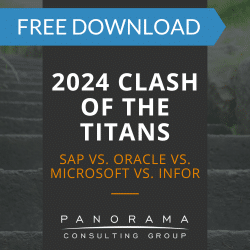You have many decisions to make during an ERP implementation. One of the most important decisions is what type of ERP implementation you want to pursue.
Do you want to do a gradual rollout? Do you want to go live with everything at once?
The latter is referred to as a big bang implementation. This can work well for some organizations, but it isn’t always recommended for others.
Today, we’re discussing big bang vs phased implementations, so you can weigh the pros and cons and decide which route is best for your company.
What is a Big Bang Implementation?
The term “big bang ERP implementation” is used to describe a go-live scenario where you migrate to the new system at a single point in time. This means all the company’s modules and offices go live simultaneously.
Big bang ERP implementations work best for organizations that only have one or two functional areas that will be using the new software.
Even in these cases, a system crash would be disastrous, so we always recommend that businesses develop a contingency plan to ensure they can recover their data if necessary.
One of the main cons of a big bang approach in ERP is that you might miss the opportunity to gradually resolve bugs and compatibility issues. As a result, you might discover a major issue when you’re already live. This is why, ERP system testing and data validation techniques are essential.
Despite the risks, the big bang approach in ERP does have plenty of benefits. Chiefly, companies that successfully manage a big bang implementation may enjoy a quicker and lower-cost rollout than companies that spread out the implementation process over a longer period of time.
Technology Assessment Case Study
We assessed the organization’s existing systems to determine which should be migrated into a centralized ERP system and which should continue to stand alone as a best of breed.
What is a Phased ERP Implementation?
With a phased implementation approach, you establish several small go-live dates for each phase of your project, rather than a single date that affects your entire enterprise.
You can set milestones based on variables, such as:
- Module
- Business unit
- Geographic location
For instance, you might go live in your accounting department on one day, and go live with your inventory and warehousing operations on another.
Why would companies want to spend the time and money required for a phased implementation? After all, one of the major drawbacks of a phased approach is that it can take a significant amount of time.
The answer lies in improved usability and adoption. One of the greatest benefits of a phased rollout is that it gives employees more time to learn and adapt to the new ERP software.
If you’re phasing by module, you can stagger end-user training so employees have more time to absorb certain aspects of the system; and if you’re phasing by business unit or geographic location, you can develop a more targeted organizational change management approach.
Ultimately, many organizations choose a phased ERP implementation approach because it allows them to identify and fix smaller, more incremental system issues.
Bridging Old and New ERP Systems
One thing to keep in mind if you’re considering a phased ERP implementation approach is that you’ll likely need to keep your old and new systems temporarily bridged as you migrate data. This ensures employees have all the data they need to do their job.
While this might sound complicated, there are system adjustments you can make that can help establish the bridge and ensure functionality.
For instance, you can use specialized interfaces to create the connection and put standard operating procedures (SOPs) in place to define how business processes will operate during the interim.
The Hybrid Approach
If your project team is at an impasse, you could consider combining both approaches, rather than seeing the choice as an “either-or” scenario.
One popular method is to use a big bang implementation for smaller business units and transition into a phased implementation for larger business units.
Choosing the Right ERP Implementation Method
IIf you’re in the pre-implementation phase of your project and you’re trying to decide between a big bang ERP implementation and a phased implementation approach, it helps to understand your unique business needs. What works for one company might not work for others.
If you have multiple sites or business units, a phased ERP implementation is usually the most practical. However, if you’re at the helm of a smaller organization and are willing to assume the risk of a big bang approach in ERP, you may be able to enjoy a faster and more cost-effective project.
Looking for an implementation partner as you make this decision? Our ERP consultants can help you determine an implementation strategy that aligns with your ERP project goals. Request a free consultation below.













